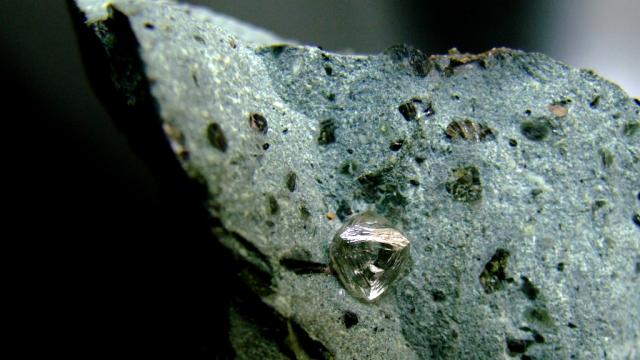Diamonds, the super-strong and brilliant crystals of carbon atoms produced under the Earth’s crushing pressures, are typically valued for their beauty and durability. But scientists also value them for another reason: They contain all kinds of hidden messages about the Earth’s mantle. You just need the right tools to read them.
Diamond in a matrix from a South African mine. Photo: StrangerThanKindness (Wikimedia Commons)
An international team of scientists have decoded one of those messages, which came in the form of high-pressure ice crystals present in diamonds. Perhaps confusingly, this ice is a sign of liquid water from deep in the mantle. These diamonds could help researchers understand just how much water hides beneath our planet’s crust.
“One essential question that we are working on is how much water is actually stored in the mantle. Is it oceans, or just a little bit?” study first author Oliver Tschauner from the University of Nevada, Las Vegas told Gizmodo. “This work shows there can be free excess fluids in the mantle, which is important.”
The mantle is a layer of mostly solid and very hot rock under immense pressure beneath the crust. It makes up the bulk of the Earth’s volume. It has an upper layer, a transition zone and a lower layer. The upper layer has a little bit of water, but scientist estimate 10 times more water may be in the transition zone, where minerals seem to be more soluble. The lower layer’s minerals don’t seem to hold water as well.
There’s already evidence of water in the mantle in different forms, such as water that has been broken up and incorporated into other minerals. But these diamonds contain water frozen into a special kind of ice crystal, called ice-VII. There are a lot of different ways water can crystallise into ice, but ice-VII is formed under higher pressures.
Essentially, while the diamond was forming, it must have encapsulated some liquid water from around the transition zone. The high temperatures prevented this water from crystalising under the high pressures. As geologic activity moved the diamonds to the surface, they maintained the high pressures in their rigid crystal structures – but the temperature dropped. This would have caused the water to freeze into ice-VII.
Geologists discovered these (very impure) diamonds in mines in southern Africa, Zaire, Sierra Leone and China, and the scientists identified the ice based on how X-rays bounced off of the specimens at the Advanced Photon Source synchrotron particle accelerator at Argonne National Lab in Illinois. The researchers published their results today in Science.
This work impressed other researchers. “In terms of science that goes into this, it’s very high-quality work and extraordinarily convincing,” Wendy Panero, professor at The Ohio State University who studies high-pressure material inside the Earth, told Gizmodo. “They really poked and prodded this ice from every direction.”
Panero, who was not involved in this study, again stressed that this isn’t the first evidence of fluid water in the mantle. Study author Tschauner pointed out that others have found diamonds with chemically bound water – but this, instead, is free water that’s frozen into ice. Panero also reminded me that the Earth’s mantle is solid, but this offers evidence of fluid flowing around inside the transition zone.
Another researcher not involved in this paper, Katie Kelley from the University of Rhode Island, thought it was interesting geologically. Researchers previously thought that tectonic plates subducting into the Earth’s interior were “bone dry”. But perhaps they’re bringing water down into the mantle with them. “That does flip our perspective of the balance of water between the surface and the interior of the planet,” she said.
Kelly also felt that a study like this offers a compelling way to look at the Earth, and that others may rush to verify this data by looking at other diamonds. Tschauner, too, pointed out that there are still active questions, and that examining the junk that gets brought up by diamonds can help shed light on the complexity of the Earth.
“We don’t have enough information from natural samples for understanding the deeper parts of the Earth,” he told Gizmodo. “Now that we have the techniques to analyse these inclusions in diamonds, I think there will be much more coming out in the future.”
[Science]
